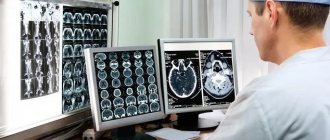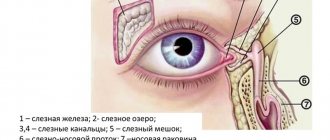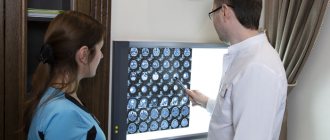Some people need attention. To listen to complaints, sympathize, and try to help. Others want a quick result—a “magic pill” or procedure that will solve all their problems. Third, to find answers to the questions “What is the cause of the condition and how can it be cured?”
Our main goal is to conduct a thorough diagnosis, find out what was the “triggering factor” of the disease and eliminate the cause of the disease. Not forgetting about attention to the patient, concern for his condition, friendly attitude and accuracy during manipulations.
How we do it: diagnostics at East Clinic
We carry out diagnostics in several stages:
Stage 1. Ask questions
This is where diagnosis begins. Each patient has his own specific questions, but there are also general ones: what worries the patient, how the disease appeared, how it manifested itself, how the symptoms developed and what accompanied them.
Stage 2. Conduct an inspection
The doctor examines the patient in parallel with the interview. Assess the condition of the musculoskeletal system, conduct neurological or osteopathic testing, palpate the abdomen if it is necessary to assess the condition of the internal organs. Also pays attention to complexion and skin condition. Any deviation from the norm can be a sign of diseases of the internal organs and even determine the prognosis of the disease.
Stage 3. We prescribe an additional examination
It happens that at the first appointment the diagnosis is not entirely clear. Then the doctor prescribes a detailed additional examination - ultrasound, MRI tests, etc.
A little about the history of the development of laboratory diagnostics
Modern laboratory diagnostics, of course, have moved far away from the research medicine of the ancients, but the experience of the discoverers of the prehistoric period turned out to be invaluable and formed the basis of science. Ancient Chinese, Indian, Persian, Greek, and Roman doctors gradually accumulated knowledge of how to examine a patient and how to treat him, based on the information received.
A significant event in the development of ancient research science was the doctrine of “bodily juices”: it was assumed that all diseases were caused by improper mixing of “juices” in the body - blood, mucus (phlegm), yellow and black bile (later this list expanded significantly). Studying the characteristics of “juices,” ancient scientists deduced several types of deviations in their “mixing,” causing pathologies that were common in those days.
Three stages of the disease were identified, distinguished by different properties of the “vital juices”. At the first stage, the “juices” became “caustic” and caused chills and fever. During the second stage, the body prepared to expel “bad juices”, and at the third (“crisis”) stage, it got rid of them (in the form of urine, feces, phlegm or sweat).
Already in those days, body secretions were studied - “by sight”, “by smell” and even “by taste”. Thus, the first experiments in studying the signs of diabetes mellitus consisted of an organoleptic analysis of the patient’s urine. More “scientific” laboratory tests were also carried out: for example, sputum was mixed with smoldering coals, and the appearance (or absence) of a fetid odor served as a certain prognostic sign.
The next leap in the development of science occurred in the second half of the 17th century. A. Leeuwenhoek invented a microscope, which allowed healers to see first blood cells and then microorganisms.
1 Laboratory diagnostics in MedicCity
2 Laboratory diagnostics in MedicCity
3 Laboratory diagnostics in MedicCity
How to prepare for diagnosis?
At home
Find and take with you all medical documents that relate to your disease - cards, extracts, ultrasound and MRI reports. If you are taking any medications for a long time, do not suddenly stop taking them. Consult your healthcare provider.
In the clinic
Answer your doctor's questions honestly and frankly. This information is strictly confidential. The doctor must have the information to make the right decision.
After the session
Try to follow your doctor's recommendations exactly. The result of treatment depends on this.
Primary doctor: Klyuev Kirill Evgenievich
Medscan Diagnostic Center
— Sergey Vladimirovich, tell us about the successful treatment of a man with recurrent prostate cancer. Your colleagues call this case a miracle.
— I won’t lie, I myself was impressed by the result that Alexander and I achieved. The man contacted me 5 years after brachytherapy performed in one of the federal government centers. The treatment did not stop the pathology, resulting in a local recurrence of the cancer. Urologists recommended that Alexander undergo palliative hormonal therapy. They predicted that radical surgery would cause complications, given the patient's advanced age and previous experience with radiation exposure. When examining Alexander, I became convinced that the tumor focus in the prostate gland was the only manifestation of the disease in the body. In this situation, there are only two options for treating a relapse - either radical surgery, which the patient has already been denied, or repeated radiation therapy. Theoretically, the second method is also associated with a high risk of complications, since the normal tissues around the prostate gland have already “selected” the radiation dose. But still, after discussing all the possible consequences with the patient, we settled on the option of repeated radiation therapy. This choice helped us achieve success.
— How were the procedures carried out and how long did the treatment take?
— In 2021, using the Varian TrueBeam linear accelerator, we performed stereotactic radiation therapy in 5 sessions for tumor recurrence in the prostate gland without any complications during the treatment process. Modern equipment, high-precision planning of radiation and special techniques for protecting normal tissues made it possible to achieve the main goal of treatment - to deliver a radical dose to a relapse and “spare” normal tissues - the rectum, bladder and urethra.
How is the patient feeling now? Do you keep in touch?
- Of course, we continue to communicate. I never leave my patients after treatment. They are all great guys, they regularly take PSA tests, record them in special diaries, and fill out questionnaires on side effects and quality of life. Alexander is no exception; he regularly checks his condition. Already during the first year after treatment, he showed pronounced positive dynamics in the form of a decrease in PSA from 4.3 ng/ml to 0.040 ng/ml. The patient did not receive hormonal therapy. No bladder, urethral, or rectal complications were noted. Now, more than 4 years after repeated radiation therapy, the patient monitors his PSA level and this indicator has remained low all these years (
“I was lucky that I was treated by a professional Sergei Vladimirovich Usychkin. In 2021, he performed a jewelry surgery to treat my poor prostate with radiation. The fact is that it was a relapse, i.e. It's a risky business. Nevertheless, brilliant work was carried out, the results of which are obvious. Now my PSA levels are good and I feel like this doctor literally pulled me out of a dangerous situation. Thank him very much!”
I was very touched by this letter.
— What would you wish for people who find themselves in Alexander’s situation?
Never despair. Don’t waste time, look for the very doctor who will find a way out of your situation. I’ll say a banal phrase, but oncology today is not a death sentence. Before my eyes, at Medscan, hundreds of patients are overcoming a terrible disease because they receive high-quality treatment and daily monitoring by doctors. We have something to be proud of!
*The patient’s name has been changed to maintain anonymity and medical ethics.
Tests for coronavirus
- Testing for coronavirus at home in 12 hours!
- Testing for coronavirus in Lyubertsy in 12 hours!
- Testing for coronavirus in Nekrasovka in 12 hours!
- Testing for coronavirus in Korolev in 12 hours!
- What to do if an employee gets sick with coronavirus
- PCR swab for coronavirus in 12 hours!
- Tests for coronavirus in 12 hours!
- Check for coronavirus in 12 hours!
- Coronavirus research in 12 hours!
- Coronavirus. Detect infection within 12 hours
- Coronavirus prevention
- Recommendations coronavirus
- Test for coronavirus using ELISA in 12 hours!
- Analysis for Covid 19 in 12 hours!
- Coronavirus testing in 12 hours!
- Testing for coronavirus in 12 hours in Mytishchi!
- Testing for coronavirus in Nekrasovka in 12 hours!
- Testing for coronavirus in Korolev in 12 hours!
- Blood test for coronavirus in 12 hours!
- SARS CoV 2
- Coronavirus symptoms
- The difference between coronavirus and SARS
- Temperature with coronavirus
- Tests and analyzes for Covid
- The difference between coronavirus and flu and colds
- Cough due to coronavirus
- Loss of smell due to coronavirus
- Sore throat coronavirus
- Headache due to coronavirus
- Runny nose due to coronavirus
- Diarrhea coronavirus
- Loss of taste due to coronavirus
- Chest pain coronavirus
- Coronavirus symptoms are rare
- Shortness of breath with coronavirus
- Take a test for coronavirus Covid 19 in 12 hours!
- Test for antibodies to Covid 19 in 12 hours!
What is the subject of laboratory diagnostic research?
Laboratory tests are prescribed by the attending physician, depending on the specifics of the disease, gender and age, well-being and complaints of the patient.
The concept of “laboratory diagnostics” includes: “collection” of biological material, its storage and transportation, direct examination and interpretation of test data.
The types of biological material that can be submitted for research are very diverse: blood, urine, feces, sputum, saliva, semen, scrapings and smears, histology samples, etc. Samples of biomaterial are sent to laboratories for analysis in a short time.
The most famous laboratory diagnostic service, which each of us has encountered more than once, is a blood test. With its help, you can identify functional disorders in organs and systems, detect signs of various (often asymptomatic) diseases and types of pathogens of infectious diseases, determine hormonal status, the state of immunity, and much more.
The main function of a clinical laboratory is to provide the doctor with objective data on the analysis of biomaterial and compare it with normal values (normal values are always displayed on test forms).
Today, laboratory diagnostics provide doctors with over 80% of all the information necessary to determine the diagnosis and control the treatment.
At MedicCity, you can take tests on the same day of treatment, receive their results as quickly as possible and, if necessary, consult with a specialist (the clinic sees doctors from over 30 specialties).
Thus, a general blood test determines the amount of hemoglobin, the number of red blood cells, platelets, and leukocytes.
Biochemical analysis examines the functions of the liver and kidneys, determines the amount of sugar and cholesterol levels, etc.
Serological tests can detect the presence of antibodies to such serious diseases as syphilis, herpes, hepatitis, rubella, toxoplasmosis, cytomegalovirus, chlamydia, etc.
With the help of enzyme-linked immunosorbent assay, doctors determine the degree of development of the disease and evaluate the effect of the treatment, receive information about previous diseases. In addition, a blood test determines the level of thyroid hormones, male and female sex hormones, the presence and duration of pregnancy, and much more.
1 Laboratory diagnostics in MedicCity
2 Laboratory diagnostics in MedicCity
3 Laboratory diagnostics in MedicCity
The MedicCity clinic cooperates with leading medical laboratories in Moscow, which carry out research that meets high international standards.
Unification of requirements for formulating a diagnosis
To implement this WHO recommendation, local (national) rules for analyzing morbidity and mortality for multiple causes were developed. In 1971 G.G. Avtandilov, in order to take into account and analyze morbidity and mortality for multiple causes, proposed the concept of “combined underlying disease” based on the identification of mono-, bi- and multicausal types of diagnoses. A combined underlying disease, represented by either two competing, or combined, or primary and background diseases, has found wide application. Rules were developed for identifying the nosological unit, which is placed in first place in the combined underlying disease, as the main unit of accounting in the statistical analysis of morbidity and the initial cause of death in case of death. However, as rightly stated in the recommendations of the Ministry of Health of Russia, the replacement of the heading “Main disease” with the concept of “combined main disease” in the case of comorbidity currently violates the requirements of the current federal legislation and ICD-10, and in case of deaths, it unnecessarily complicates the choice of the so-called initial cause of death - basic statistics of causes of death in the population.
The basis for improving the rules for formulating a diagnosis and, in case of death, issuing a medical death certificate should be based on modern definitions and requirements of the current legislation of the Russian Federation (Federal Law No. 323-FZ) and WHO experts, reflected in ICD-10.
Diagnosis
Diagnosis (Greek διάγνωσις - recognition) is a medical report on the state of health, on an existing disease (injury, condition), expressed in terms provided for by the accepted classifications and nomenclature of diseases, denoting the name of diseases (conditions), their forms, variants of the course and based on comprehensive systematic study of the patient. The content of the diagnosis can also be special physiological conditions of the body (pregnancy, menopause, the state after resolution of the pathological process, etc.), a conclusion about the epidemic focus.
Disease
The disease is defined as a violation of the body's activity, performance, and ability to adapt to changing conditions of the external and internal environment, arising in connection with the influence of pathogenic factors with simultaneous changes in the protective-compensatory and protective-adaptive reactions and mechanisms of the body.
The condition is defined as changes in the body that occur due to exposure to pathogenic and (or) physiological factors and require medical care. The leading principle of formulating a diagnosis in medicine is nosological.
Here are some terms and definitions in accordance with the industry standard OST TO No. 91500.01.0005-2001 [10]:
1) nosological form (unit) is defined as a set of clinical, laboratory and instrumental diagnostic signs that make it possible to identify a disease (poisoning, injury, physiological state) and classify it as a group of conditions with a common etiology and pathogenesis, clinical manifestations, general approaches to treatment and correction conditions;
2) a syndrome is a condition that develops as a result of a disease and is determined by a set of clinical, laboratory, instrumental diagnostic signs that allow it to be identified and classified as a group of conditions with different etiologies, but a common pathogenesis, clinical manifestations, general approaches to treatment, which at the same time depend on from the diseases underlying the syndrome.
A diagnosis is an integral expression of a medical specialist’s understanding of the patient’s health status and the existing disease (injury, condition) based on data obtained as a result of diagnostics, which is a complex of medical interventions aimed at recognizing conditions or establishing the presence or absence of diseases carried out through collecting and analyzing patient complaints, medical history and examination data, conducting laboratory, instrumental, pathological and other studies in order to determine the diagnosis, select measures for treating the patient and (or) control the implementation of these measures.
Based on the above provisions of federal legislation, the diagnosis is endowed with various functions:
1) medical: diagnosis is the basis for the choice of treatment methods and preventive measures, and also serves to assess the prognosis of the development of the disease;
2) social: the diagnosis is the basis for a medical examination (examination of temporary disability, medical social examination, military medical examination, forensic medical and forensic psychiatric examination, examination of professional suitability and examination of the relationship of the disease with the profession, as well as examination of the quality of medical care) ;
3) economic: diagnosis is the basis for regulatory regulation of healthcare within the framework of procedures for the provision of medical care, standards of medical care and clinical recommendations (treatment protocols).
4) statistical: diagnosis is a source of state statistics on morbidity and causes of death of the population. Taking into account the legally established priority of the patient’s interests in the provision of medical care, not a single function of the diagnosis can be implemented by creating conditions that could lead to a decrease in the quality of medical care. And therefore, the diagnosis should always be a complete, as far as possible in specific conditions, medical report on the state of health and the existing disease (condition).
The medical and social functions of diagnosis take priority over the economic and statistical ones. In this regard, we emphasize that any dilution or simplification of the diagnosis, motivated by the need to fit it into standardized formulations, schemes or rules, is unacceptable.
Russian healthcare has traditionally adopted a general diagnosis structure that strictly meets WHO requirements and includes the following components, or headings:
1. underlying disease - a disease that, by itself or in connection with complications, causes a primary need for medical care due to the greatest threat to performance, life and health, or leads to disability or causes death;
2. concomitant disease - a disease that does not have a cause-and-effect relationship with the main disease, is inferior to it in the degree of need for medical care, influence on performance, danger to life and health, and is not the cause of death.
It should be noted that the concepts of “main disease” and “concomitant disease” are defined by law and are not subject to modification in further discussion of these terms. From the legally established definition of the underlying disease, it follows that the structure of the diagnosis must include the heading “Complications of the underlying disease,” which determine the priority need for medical care in connection with the greatest threat to performance, life and health, either leading to disability or causing death.
Based on this provision, the general structure of the diagnosis should be represented by the following headings:
1. Main disease.
2. Complications of the underlying disease.
3. Concomitant diseases.
This classification of diagnosis was first approved by order of the USSR Ministry of Health dated January 3, 1952 No. 4 and has been preserved unchanged to this day in medical record forms.
But even with this simplest diagnosis design, difficulties may arise when choosing the main and concomitant diseases (conditions), so WHO experts have adopted a number of rules for selecting diseases (conditions) that are used in the analysis of morbidity and mortality.
Thus, it is recommended that the condition that should be used for single-cause morbidity analysis be the one for which treatment or testing was performed during the relevant health care episode. In this case, the main condition is defined as a condition (disease, injury) diagnosed at the end of an episode of medical care, for which the patient was mainly examined and treated. If there is more than one such condition (disease), the one that accounts for the largest portion of the resources used is chosen as the main one.
To analyze the causes of death, WHO experts introduced the concept of “initial cause of death,” which is defined as a disease (injury) that caused a chain of disease processes that directly led to death, or the circumstances of an accident or act of violence that caused a fatal injury.
A fatal complication that determines the development of the terminal condition and the mechanism of death (but not an element of the mechanism of death itself) is defined as the direct cause of death.
Thus, the concept of the initial cause of death is similar to the concept of the underlying disease, and the concept of the immediate cause of death is similar to the fatal complication of the underlying disease. Concomitant diseases, since they do not contribute to death and do not have a cause-and-effect relationship with the underlying disease, cannot be associated with the cause of death, are not used in the statistics of causes of death and therefore are not included in the medical death certificate.
ICD-10 defines comorbid diseases (conditions) as other important diseases (conditions) that contributed to death. In the diagnosis design, it is advisable to indicate such comorbid diseases (conditions) as competing, combined and/or background diseases (conditions) in an additional heading after the “Main disease” heading. They must have common complications with the underlying disease, since they jointly cause a chain of disease processes that directly lead to death.
Based on these provisions, the structure of the diagnosis for comorbidity should be represented by the following headings:
1. Main disease.
2. Competing, combined, background diseases (comorbid diseases, if any).
3. Complications of the main (and comorbid, if any) diseases.
4. Concomitant diseases.
Competing disease
It is defined as a nosological unit (disease or injury) that the deceased suffered from simultaneously with the underlying disease, and each of them individually could undoubtedly lead to death.
Combined disease
It is defined as a nosological unit (disease or injury) that the deceased suffered from simultaneously with the main disease, and which, being in various pathogenetic relationships and aggravating each other, led to death, and each of them individually would not have caused death.
Background disease
It is defined as a nosological unit (disease or injury), which became one of the causes of the development of another independent disease (condition), aggravating its course and contributing to the occurrence of general fatal complications leading to death.
According to WHO rules, only one of these conditions, selected according to the ranking tables recommended by WHO, should be considered as the underlying cause of death. In the diagnosis, this disease (condition) is indicated under the heading “Main disease” and is included in part I of the medical death certificate. All other diseases (conditions) associated with the cause of death (competing, concomitant and background), in accordance with the recommendations for the need for analysis for multiple causes, should be reflected in Part II of the medical certificate of death as other important conditions contributing to death.
Thus, the structure of the diagnosis should include the following sections: the main disease, complications of the main disease and concomitant diseases. The heading “Main disease” indicates only the disease (condition) that became the reason for carrying out therapeutic and diagnostic measures during the last episode of medical care, and in case of death, by itself or through its complications could lead to death. This disease (condition) is indicated and coded in Part I of the medical death certificate as the underlying cause of death.
In the corresponding paragraphs of Part I of the death certificate, the immediate cause of death (fatal complication) and the so-called intermediate conditions are recorded, which are selected from the section “Complications of the underlying disease”, but are not coded. In case of comorbidity, other important diseases (conditions) that became the reason for the provision of medical care, and in case of death, contributed to death, defined as competing, combined and/or background diseases, are indicated in the diagnosis in an additional heading after the heading “Main disease” and are entered accordingly , in part II of the medical death certificate with the corresponding ICD-10 codes.
Concomitant diseases (conditions) are not included on the medical death certificate and are not coded as having no cause-and-effect relationship with the underlying disease, and in the event of death, not influencing the occurrence of death.
Information about authors:
Zairatyants Oleg Vadimovich – Doctor of Medical Sciences, Professor, Head of the Department of Pathological Anatomy, Moscow State Medical and Dental University. A.I. Evdokimov" of the Ministry of Health of Russia, Vice-President of the Russian and Chairman of the Moscow Society of Pathologists
Malkov Pavel Georgievich - Doctor of Medical Sciences, Associate Professor, Professor of the Department of Pathological Anatomy of the Russian Medical Academy of Postgraduate Education of the Ministry of Health of Russia, head of the pathological anatomy course of the Department of Physiology and General Pathology of the Faculty of Fundamental Medicine of the Federal State Budgetary Educational Institution of Higher Education "Moscow State University" them. M.V. Lomonosov"
Lev Vladimirovich Kaktursky – Corresponding Member of the Russian Academy of Sciences, Doctor of Medical Sciences, Professor, Scientific Director of the Federal State Budgetary Institution “Research Institute of Human Morphology”, President of the Russian Society of Pathologists (Moscow)
Share on social media networks









